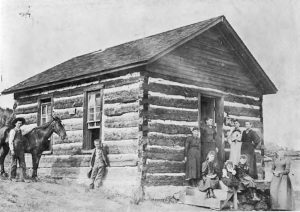The Buntains: early is as early does

Early Jarre Creek School where Haskell likely was schooled.
Young people of the 21st century seem to be marrying later and fretting more, enjoying the lack of early responsibilities prior to taking on life-altering commitments. A good plan if you’ve got money or accommodating parents. Not so with Sedalian Thomas Buntain. He served in the Civil War as early as 17, marrying his bride Bertha Rouse, a 14-year-old, in 1888. Share this factoid with friends or family for some raised eyebrows…
Reports of Buntain’s early life in Ohio had him farming in the late 1850s. For reasons unknown, he became a soldier. When the Civil War ended, he separated from the army in Omaha, a few dollars in his pocket. Most of it he used to purchase a horse and then rode off into the sunrise. By 1882, he had found his way to Sedalia.
Using the benefit of a veteran’s tenure in the Homestead Act, he claimed a 160-acre homestead on lower Jarre Creek Road. Bertha and two of her sisters had long lived there, deeper in the canyon, with a lumberman father and a Native American mother. (The Papoose Club, a sports and recreation club, occupies that same location today).
The Buntains became parents to an only child, Haskell, born in their homestead cabin. He was schooled up and down the canyon, first in Jarre Creek and then Indian Creek School, because his parents relocated to Jack Butterfield’s place later in his childhood. (Butterfield’s uncle had earlier founded the Butterfield Stage Coach Line.)
Things went poorly with Tom and Bertha’s marriage. Haskell remained with his father, effectively becoming a latchkey kid. He was resourceful, if nothing else, doing busywork for the locals as a teenager, including Dr. Minnie Love who paid him the princely sum of $3 a week. At the time, Haskell was fascinated with target shooting, spending much of his earnings on ammunition, benignly shooting up Madge Gulch.
There were udder means for Haskell to make a buck in the canyon, and he found work in the dairy industry. That early experience likely later facilitated an operating partnership agreement with his cousin, Bob Brown. For a while, they contract ranched 3,200 acres known as “Mirador,” near SH 105.
Haskell frequently passed through Madge Gulch. There, he encountered a visitor, Alice Manker, whose mother Nellie owned a place near Dr. Love’s spread. A lively romance blossomed and they married a year later. Lately of Lincoln, Nebraska, and a city girl, Alice adjusted quickly. Completely unfamiliar with standard wood stoves of the day and devoid of any ranching experience, she learned what she had to learn. To her credit, later accounts of her cooking made her famous among those up the Jarre Creek Road.
Earlier a robust outdoorsman, Haskell’s health disintegrated, asthma preventing him from meeting any further ranching demands. Abandoning their way of life in 1943, the Buntains relocated to a caretaker’s cottage on the grounds of the newly constructed Charlford Castle of Charles Johnson. From there, Haskell sold real estate. (Charlford sold in the 1950s and the estate would be renamed “Cherokee Castle” by Tweet Kimball).
As the sun set on the Buntains’ vigor, the couple wisely moved down to Sedalia in 1955. Nine years later Haskell passed away. In her waning years alone, Alice occupied the original Sedalia schoolhouse and called it “home.”
By Joe Gschwendtner; photo courtesy of Sedalia Historic Museum and Gardens